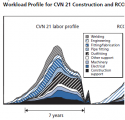The meaning of "successfully" can only be assess at least upon completion and not before and why the alternate description used is unproven. I don't understand how you can argue for success before the fact. I am not saying that China cannot get to the end point - eventually, but there are two steps ahead. Firstly, successfully build a carrier based off the Liaoning design (with some modifications). As I understand it, China has the blueprints. The second step is to migrate to CATOBAR which would mean a new design and another significant challenge. Attempting both steps concurrently while step one is still unproven is in my view not likely.
The issue I had with your previous statement was "The technical capability to build a carrier is unproven."
If you mean that only within the scope of concurrent development being unlikely or unacceptably risky, then I have no issues with your logic.
If you mean that statement to refer to an inability to build or develop a new carrier (alone), then I disagree.
I suppose what is worth considering, is whether the Chinese shipbuilding industry at present has the capability to design and build a new carrier mostly from the ground up (AKA what we believe 002 will be like) vs if the industry is able to build 001A (assuming it is a modified CV-16), and whether development of 001A alone would constitute a risk at all?
Putting it another way, what would be the differing risks of:
1: building only 001A at its speculated start time
2: building 001A and 002 near concurrently
3: building only 002 at its speculated start time (in other words, at the time that many at present expect 002 to emerge, but with no 001A either preceding it or near concurrently)
.... if the risks of 2 and 3 are similar, then I'd say the issue isn't so much about concurrent development of two carriers but whether the industry can design and build a new design by themselves without having built from the ground up, a derivative of a proven design.
Of course this is assuming that 001A and 002 in all three cases would have the same amount of funding and expertise directed to each.
Last edited:

